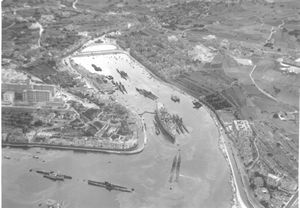Catalogue number 73151
H.M.S. Forth, 1952
What a sight ! There are 18 submarines in the photograph taken in 1952 at Pieta Creek, Malta. The 1st Submarine Flotilla was based in Malta. In 1952, the Mediterranean submarine fleet consisted of H.M. ships Sturdy, Sanguine, Sentinel, Tabard, Teredo, Trump, Token and Trenchant, depot ship H.M.S. Forth. The NATO naval exercise Longstep took place in the Mediterranean Sea in late 1952 so we may suppose that there are several participants in this photograph. In the exercise, American, British, French, Greek and Turkish submarines formed the enemy Green Forces with the aim of disrupting an amphibious landing by the Allied Blue Force. Note the floating walkway between Forth and the quayside. There are still several buildings without roofs destroyed during the war.
Verso: Mauve stamped "H.M.S. Falcon 8 Nov 1952"
Credit: Crown copyright
20.5cm x 14.6cm Gelatin silver print
|
 |